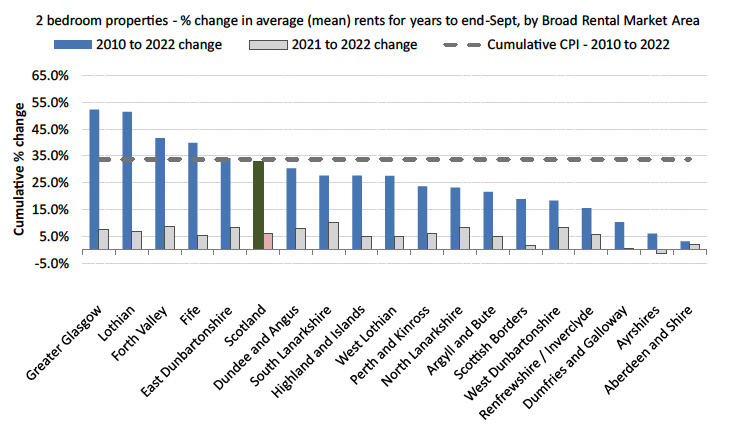Private Sector Rent Statistics, Scotland, 2010 to 2022
This publication presents statistics on average private sector rent levels in Scotland by Broad Rental Market Area and size of property, for the years 2010 to 2022.
4. Main Findings for 2 Bedroom Properties
In the year to end September 2022, average 2 bedroom rents increased in 17 out of 18 areas of Scotland. Increases in 7 of these areas were above the average 12-month UK CPI inflation rate of 7.6%, with the largest increase being 10.3% in South Lanarkshire. The average 2 bedroom rent in the Ayrshires decreased by 1.5%.
Average rents for 2 bedroom properties at the Scotland level increased by an estimated 6.2% between 2021 and 2022, to reach £736 in 2022, which compares to an average increase in UK CPI of 7.6% across the year to September 2022.
Figures on longer term changes to rents for 2 bedroom properties over the period from 2010 to 2022 should be considered in the context of the cumulative increase in UK CPI of 33.7% from the year to end September 2010 to the year to end September 2022.
Over the 12 year period from 2010 to 2022, five areas (Greater Glasgow, Lothian, Forth Valley, Fife and East Dunbartonshire) have had rent increase above CPI inflation. Greater Glasgow and Lothian have seen the highest cumulative increase in private rents for 2 bedroom properties, with average rents rising by 52.3% and 51.5% respectively, equating to annualised growth rates of 3.6% and 3.5% when calculated on a compound annual increase basis between 2010 and 2022.
For the remaining areas of Scotland, cumulative increases have been below CPI inflation and have ranged from 3.1% in Aberdeen and Shire to 30.3% in Dundee and Angus.
These regional trends combine to show an estimated 32.9% cumulative increase for 2 bedroom properties between 2010 and 2022 (equating to an annualised growth rate of 2.4%), to reach £736 in 2022. See Table 2 and Chart 4 below.
| Broad Rental Market Area |
2010 |
2021 |
2022 |
2010 to 2022 change |
2021 to 2022 change |
|---|---|---|---|---|---|
| Greater Glasgow |
564 |
797 |
858 |
52.3% |
7.7% |
| Lothian |
665 |
942 |
1,006 |
51.5% |
6.9% |
| Forth Valley |
492 |
642 |
697 |
41.6% |
8.7% |
| Fife |
464 |
616 |
649 |
39.9% |
5.3% |
| East Dunbartonshire |
581 |
721 |
780 |
34.2% |
8.2% |
| Scotland |
554 |
693 |
736 |
32.9% |
6.2% |
| Dundee and Angus |
497 |
601 |
648 |
30.3% |
8.0% |
| South Lanarkshire |
481 |
556 |
613 |
27.7% |
10.3% |
| Highland and Islands |
503 |
612 |
643 |
27.6% |
4.9% |
| West Lothian |
527 |
642 |
673 |
27.5% |
4.7% |
| Perth and Kinross |
506 |
590 |
626 |
23.6% |
6.1% |
| North Lanarkshire |
455 |
517 |
560 |
23.1% |
8.3% |
| Argyll and Bute |
503 |
583 |
612 |
21.6% |
5.0% |
| Scottish Borders |
442 |
516 |
525 |
18.9% |
1.7% |
| West Dunbartonshire |
492 |
537 |
582 |
18.2% |
8.3% |
| Renfrewshire / Inverclyde |
473 |
518 |
547 |
15.6% |
5.6% |
| Dumfries and Galloway |
435 |
477 |
480 |
10.2% |
0.6% |
| Ayrshires |
464 |
500 |
493 |
6.1% |
-1.5% |
| Aberdeen and Shire |
643 |
649 |
663 |
3.1% |
2.1% |
Note: See the Supporting Documents Excel Workbook Table 7 for a more detailed breakdown of quartile and average rents for each year. Also note that the Scotland figures have been calculated using a weighted stock approach, with further information on this available in Section 8 and Annex C.


Contact
Email: housingstatistics@gov.scot
There is a problem
Thanks for your feedback